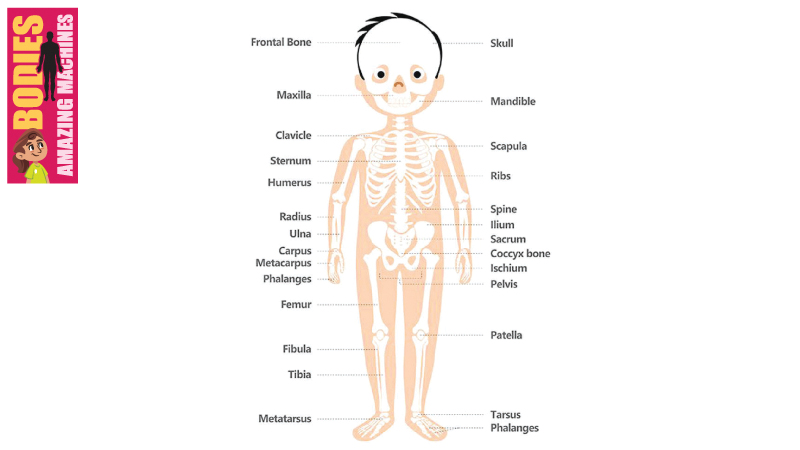Did you know you have your very own suit of protective armour inside your body? It’s called your skeleton, and it’s made of strong, living bones that help you stand, move, grow, and stay safe. Your skeleton works like a team of quiet heroes—always busy, even while you’re sleep.
Let’s take a fun journey through your skeletal system and meet your bones.
What is a skeleton?
A skeleton is the bony structure inside your body. It gives you your shape and supports your muscles, skin, and organs. Without bones, you’d be a messy blob of jelly.
• Babies are born with about 300 bones, but as they grow, some bones fuse (join together), so adults have 206 bones.
• Bones come in all sizes and shapes—long, short, flat, and curved.
What do bones do?
Your skeleton does more than just hold you up. Here are its five awesome jobs:
1. Support: Bones give your body structure so you don’t collapse like a noodle.
2. Movement: Muscles attach to bones. When you move your muscles, they pull on the bones—ta-da ! You run, jump, wave, skip and dance.
3. Protection: Bones guard important organs.
• Skull protects your brain
• Rib cage protects your heart and lungs
• Backbone (spine) protects your spinal cord
4. Blood cell factory: Inside some bones is a soft part called bone marrow. It makes red blood cells (carry oxygen) and white blood cells (fight germs).
5. Storage: Bones store minerals like calcium and phosphorus, which help keep them strong.
Know your major bones
Here are some important bones you use every day:
• Skull: Hard helmet-like bone that protects your brain.
• Spine (Vertebral Column): A long stack of small bones (vertebrae) that lets you twist and bend. It holds up your head.
• Ribs: Curved bones that form a cage around your chest. Most people have 12 pairs.
• Pelvis: A big, bowl-shaped bone that supports your body and helps you sit and walk.
• Femur: Longest and strongest bone in your body—it’s in your thigh.
• Humerus: Bone in your upper arm.
• Radius and Ulna: The two bones in your forearm.
• Tibia and Fibula: The two bones in your lower leg.
• Phalanges: Tiny bones in your fingers and toes.
Fun bone facts
• Your jawbone is the only part of your skull that moves.
• Your ears have the tiniest bones in your body—they help you hear.
• Bones are stronger than concrete, but light enough to help you move fast.
• Your bones renew themselves every 7–10 years.
What are joints?
Joints are where bones meet. They let you move in different ways:
• Ball-and-socket joint (shoulders, hips) → moves in all directions
• Hinge joint (elbows, knees) → bends and straightens
• Pivot joint (neck) → allows rotation
• Gliding joint (wrists, ankles) → bones slide past each other
Joints have cartilage (a soft cushiony material) so bones don’t rub painfully.
Bone care 101
Want strong bones?
Here’s how:
• Eat calcium-rich foods – like milk, cheese, yogurt, broccoli, leafy greens, nuts, seeds, dried fruit and tofu.
• Get sunshine – sunlight helps your body make Vitamin D to absorb calcium.
• Exercise – sports like running, jumping, and dancing keep bones healthy.
• Wear safety gear – protect your bones with helmets, pads, and seatbelts.
Why your skeleton matters
Without your skeleton, you couldn’t walk, run, play, or even sit up. It’s your silent supporter—working 24 hours a day to keep you upright, moving, and safe.
So next time you stretch, kick a ball, or even wiggle your toes, say “thanks” to your bony best friend—the super skeleton in you.






